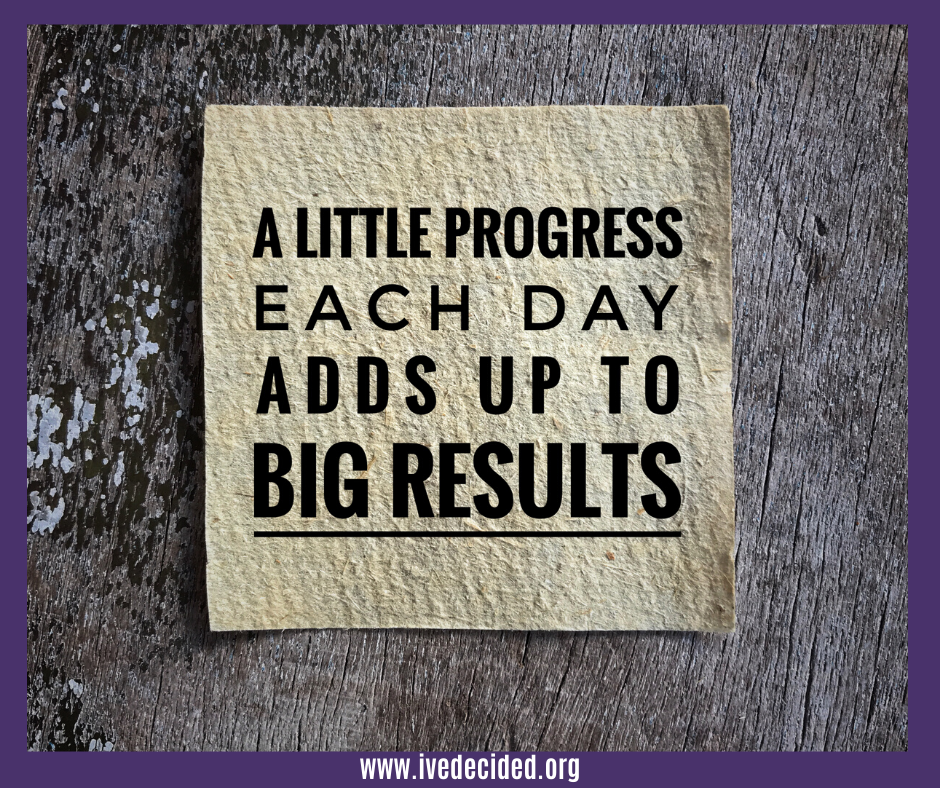One of the reasons people give up too soon on their goals and dreams is because it can feel like it’s taking longer than it should to see the expected results. You could be moving along as fast as possible towards your goal but because you have a big goal, it could feel like it’s taking an eternity to get nowhere! If you have ever tried to lose a lot of weight, get out of debt, kick a bad habit, or finish a huge home improvement project, then you understand what we mean. You’ve most likely experienced the feeling that you’re just not getting anywhere. Maybe, you feel that way now. Before you give up on your goals and dreams, let’s take a look at how much progress you really are making.
How can you be sure you’re making progress? Here are 4 ways you can be certain you’re making strides towards your goals and dreams.
- Have a reasonable time-line – Match your progress with the level of difficulty of your goal. Be sure you have done the research and understand the full scope of what it will take to achieve your goal. Let’s use losing weight as an example. Say you have 25 pounds to lose, and you start exercising every day. Additionally, you make an exerted effort to reduce your calorie intake by 500 calories per day. You may feel like you should be losing 5 or more pounds per week based on how hard you’re working, but the reality is, 3500 calories equals a pound, and an average workout burns about 250-300 calories at best. You can go on the high end and assume you’re at a negative of 800 calories per day. If you divide 3500 by 800, you will lose 1 pound about every 4-5 days on average. The only exception to this may be in that first week or so because most people lose some excess water weight, but after the first week or two, these are the numbers you could expect based on science. So, to lose 25 pounds for the average person based on the example we used, would take approximately 4 months- 5 months, and that’s if you’re absolutely perfect with no slip-ups. This is not what the average person who wants to lose 25 pounds likes to hear, and it’s usually why most people give up to soon on their weight loss goal. Really, most anything you want to achieve can be equated to this example. The good news though, If you make sure you create a reasonable time-line for yourself starting your goal, and acknowledge the reality of how long it will take you, you set yourself up for better results. You will also be able to see when you’re making progress because you won’t have an unrealistic idea of how far along you should be simply based on the work and time you’re putting in.
- Track your results – A smart goal should always be measured. You must take the time to track your results. You can monitor them using a spreadsheet, a graph, a success partner, or any kind of chart, but the point is to track consistently. When tracking, you want to make sure you have a baseline of where you’re starting. Using the example of losing weight, you would weigh yourself before you start and take before pictures. You could also have a pair of jeans that won’t fit or that are too tight to help you see progress. The more ways you utilize to track your progress, the better. Be sure to create benchmarks to celebrate. This is a way you can celebrate the small victories along the way, and it will help you stay motivated to keep going. Tracking will also allow you to begin to see patterns of habits you can work on, or obstacles that you didn’t think about. Tracking your results will help you stay focused and see the progress you’re making. If you’re serious about achieving your goal, you must have a means to track your results.
- Assess your situation on a regular basis – You will need to assess your situation on a regular basis and make any necessary changes. For example, you may find you don’t like working out at a certain time or it simply doesn’t fit in your schedule during that time frame, so you will need to alter the times you go to the gym. Ask yourself some questions; What challenges have come up that I didn’t expect? What opportunities are available to me that I haven’t explored yet? Remember, achieving a goal is a journey, and there are going to be times you may get frustrated, or feel you aren’t making the progress you would like. When this happens, you must take the time to assess the situation and make any adjustments to keep going.
- Give yourself credit – You are so much more than you may think you are and most likely way more accomplished than you give yourself credit for. When is the last time you gave yourself a pat on the back for all the hard work, effort, and progress you have already made? Remember, positive reinforcement is the best kind of reinforcement. You must watch the negative self-talk that can creep in because it can ultimately destroy your chance of success. Negative self-talk can happen when something goes wrong. You can start blaming yourself or being overly hard on yourself. Be aware when this starts to happen and redirect immediately. Make a list of the things you have accomplished and give yourself credit for where you are today. You may not be where you want to be, but you’re not where you were.
Progress is a good thing no matter how slow it may seem. Remember 3 steps forward and 2 steps back will still eventually get you where you want to go. A little progress everyday adds up to big results over time. Remember the tortoise and the hare? Progress may be slow, but quitting won’t make it any faster.


